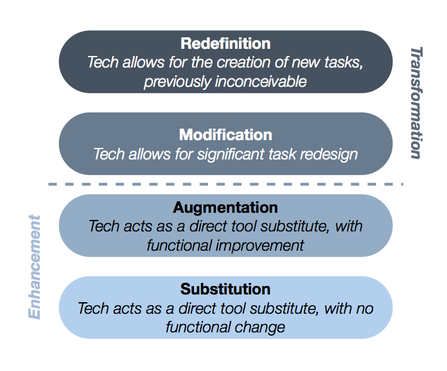 When I was a kid, I wanted to be just like Bill and Ted…you know, those guys who had a totally gnarly, totally Excellent Adventure? Here’s a video clip to refresh your memory: Aside from rockin’ the grunge clothing and playing a mean air guitar, the coolest thing about Bill and Ted was their time traveling phone booth – which, you have to admit, is a pretty neat concept. Every time I browse one of thoseAs Seen on TV stores, I keep hoping it’ll pop up. Until it does, however, there is another way more excellent option to transport you and your students to another place: Tourwrist for iPad. If you haven’t played around with this app, you’re missing out. Furthermore, if your students haven’t played around with this app, then they’re missing out. The function of the app is just what the name implies – taking tours of far-off places with a flick of your wrist. There are some fairly well put together web-based virtual tours out there, but the quality of the 360 degree tours on Tourwrist take the concept of virtual exploration to a whole new level. Opening a tour in this app is the closest thing to actually being there. Dude. Does This Thing Come with an Instruction Manual? Today I had my students use Tourwrist to explore the pyramids, the Great Sphinx, and an ancient cemetery in Egypt. How was this possible? See below for a video tutorial… Dude. Why Does This App Rock?As a result of using this app in class, students were ridiculously engaged, highly motivated to complete the assignment, and eagerly participated in some really fantastic academic conversation. Their assignment was accomplished in several parts. First, students watched a video clip about Egyptian religion on their iPads, then explored the Tourwrist app. They used Safari to search for credible sources of information about Egyptian religion and created a Circle Map to share their discoveries. By far, students were most excited about using Tourwrist and were able to draw a lot of really great conclusions based on what they saw. Here are a few quotes from student work:
As a teacher, it was incredibly fun to watch my students engage in learning with excitement and a genuine sense of curiosity. Once a few of the students had finished the assignment, they asked to go back into the app to explore other places in Egypt. They were able to tour some Egyptian homes, the inside of an Egyptian classroom, and other famous historical landmarks. I could tell my kids were excited by the quality of the conversations they continued to have; students were drawn to similarities they saw between themselves and modern Egpytian households, and loved sharing connections they made with each other. Here are a few of their reactions that I captured with my iPhone: Dude! How 'Bout Some Integration Ideas? Tourwrist could be easily integrated into almost any content area with any grade level, because it's just so darn engaging and fun to use. Consider trying out one of the following ideas in your classroom:
Well, it’s definitely not Bill and Ted’s phone booth, but it is remarkable. Tourwrist: An app every teacher should use. Have you used Tourwrist in your classroom? Are you inspired to use Tourwrist after reading? We’d love to hear from you, so share your thoughts by commenting. Happy travels!
0 Comments
 As election season creeps up on us like a herd of thundering rhinoceroses, I am constantly reminded by CTA that I should vote to support education (no kidding?), reminded by the district that our situation will become dire unless much needed fiscal relief arrives in the form of propositions passed (is this how Marie Antoinette felt pre-guillotine slice?), and reminded by my wallet that I really need a bigger classroom budget if I’m going to pull off the 2012-2013 school year. As the budget gap widens in the state of California, educators are getting more and more creative about how they get things done. I’m pretty sure I’ve even seen this guy wandering in and out of the staff room at my school site: In the last month, I’ve heard district office administrators recommend that school sites begin devoting more funds toward the purchase of technology, because of the impending shift to Common Core. Ironically, I’ve also heard school site administrators say that the district office will have to devote more funds toward the purchase of technology. (Did you catch that swinging door of pass-the-buck responsibility?) And now, the latest and greatest plan is to shift the responsibility for tech purchasing onto students themselves by launching a student-centered BYOD program. I’ll be honest: At the moment, I have a somewhat Jekyll and Hyde relationship with the concept of BYOD. While I enthusiastically embrace BYOD based on the fact that it will allow my students to have a 1:1 tech access, I also recognize that there are definite limitations to the transformative impact of BYOD. Take, for example, the SAMR scale of technology implementation (which can be found here originally): A BYOD program can only support technology integration so far before it ceases to be an effective mode of transformation. Bringing any Internet-enabled device can get you into some pretty cool technology enhanced lessons, but the plethora of devices actually creates an uneven playing field. For example, many of my favorite apps are not marketed in both the iOS and Android stores. So, let's say that I want students to make a video project to express their learning. There are few variables that have to be addressed:
If a student is using an eReader, then the answer to the first question would be a resounding “no.” If a student is using an Android device, eReader, or PC laptop, then the answer to the second question is also, “no.” Of course there are ways around these issues, such as asking students to share devices, but that sort of defeats the 1:1 purpose of BYOD and also therefore limits the transformative learning that can occur. More effectively, districts might consider a specified BYOD program. As in, a “Bring Your Own [Blank]” program that could target a specific device students could bring to use in the classroom. For example, about half of the students in each of my classes is using an iPod, iPhone, or iPad for their device. I think the potential for awesome exponentially increases when devices are equalized. Instead of school supplies, students could purchase certain core apps and download a ton of free apps for classroom use. The limited funds the district and individual school sites have could then be directed toward purchasing supplemental devices that sustain the momentum created by the BYOI(pod, pad, phone) concept. Ultimately, it comes down to the type of learning in which you want students to engage. Podcasting, video production, multimedia presentations – those are not expressions of learning that can be universally accomplished. There are plenty of Web 2.0 tools to help fill in the gaps, but can those really compare to a creative suite of apps? Whatever the platform or device, there’s something to be said for uniformity. Would it be too much like reading a fortune cookie if I said something along the lines of, “In uniformity, we find creativity”…? Well, I’ll leave you with this, then, at the risk of letting my Apple geek out of the box: |
Author: Jessica PackCalifornia Teacher of the Year. CUE Outstanding Educator 2015. DIGICOM Learning Teacher Consultant. 6th Grade Teacher. Passionate about gamification, Minecraft, digital story-telling, and fostering student voices. Download:Archives
June 2020
Categories
All
|


 RSS Feed
RSS Feed